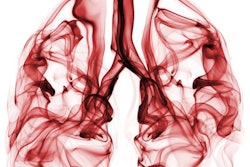A new study finds that CT can apportion the blame for lung function impairment between patients' asbestos exposure and their smoking-related emphysema.
The multi-institutional series compared CT findings with lung function measurements. The preliminary results will require further validation, but the authors believe the results are clear enough to have medicolegal implications, inasmuch as doctors have traditionally found it difficult until now to differentiate between the two common causes of lung impairment.
"Cigarette smoking is common among workers exposed to asbestos, and emphysema frequently complicates the interpretation of physiologic impairment in patients with asbestosis," explained principal investigator Dr. Susan Copley and her colleagues from London-based Hammersmith Hospital and other institutions. "This poses a problem for objective evaluation and management. Further, compensation entitlements are largely related to damage from asbestosis but not emphysema, and the relative contribution of asbestosis and emphysema to functional impairment is medicolegally contentious" (Radiology, January 2007, Vol. 242:1, pp. 258-266).
The participating institutions included London's Royal Brompton Hospital, University College London, and the London Chest Hospital, as well as researchers from the University of Western Australia in Perth, and Middlemore Hospital and the University of Auckland in New Zealand.
The study sought to retrospectively correlate the extent of individual disease at thin-section electron-beam CT with pulmonary function measures in patients with asbestosis. Lacking a better reference standard, the validity of the findings was tested in a control group presenting with similar demographics and somewhat milder disease characteristics.
The researchers examined 133 individuals who had been exposed to asbestos (79 men, two women; mean age 67), and had CT features of asbestosis. Half were miners with generally heavy exposure to asbestos. Two observers used a CT scoring system to quantify the extent of pulmonary fibrosis, diffuse pleural thickening, small airway disease, and emphysema.
CT scanning was performed with an electron-beam scanner (Imatron C-100, GE Healthcare, Chalfont St. Giles, U.K.) or spiral CT scanner (Somatom Power and Somatom Plus, Siemens Medical Solutions, Malvern, PA; or Xpress, Toshiba America Medical Systems, Tustin, CA).
Images 1-3 mm in thickness were obtained at 10-30-mm intervals in all patients, with images obtained during full inspiration. The data were reconstructed using a bone algorithm, and acquired using appropriate window settings (window center -600 to -655 HU; window width 1,500-1,850 HU).
Two highly experienced thoracic radiologists, blinded to all results, evaluated the image data independently, formulating multivariate equations using independent CT variables to predict changes in total lung capacity (TLC) and carbon monoxide diffusing capacity (DLCO), the authors explained. All images were scored to record the extent of fibrosis, emphysema, small-airway disease, pleural disease, and bronchiectasis, as well as other features associated with bronchiectasis. Total disease extent was estimated at the level of the great vessels (level 1) and aortic arch (level 2).
Then the validity of the equations in the study cohort was tested against those of another group of demographically similar patients (52 men, median age 60), who had worked in various asbestos-related industries, and presented with parenchymal lung abnormalities similar to those of the first group.
The results showed that both emphysema and the extent of asbestos-induced pleuropulmonary disease correlated significantly to the degree of physiologic impairment (p < 0.001).
"Combined CT variables predicted 58% and 57% of the variability in TLC and DLCO, respectively, despite considerable variation in the proportion of coexisting pathological conditions," the authors wrote. "When predictive equations with CT variables derived from the initial study group were applied to the subsequent study group, predicted TLC (p = 0.75, p < 0.001) and DLCO (p = 0.64, p < 0.001) correlated strongly with measured values."
CT significantly increases the precision with which pulmonary function test results can be interpreted in patients exposed to asbestos, the authors wrote.
In individuals exposed to asbestos, the functional consequence of that exposure as opposed to those of smoking is an important medicolegal problem "because emphysema is generally not compensable," they explained. "No robust method is currently available for this purpose, and the degree of physiologic impairment attributed to asbestos exposure in smokers is often estimated arbitrarily."
Multiple regression analysis enabled the group to identify the CT features most closely linked to pulmonary function indexes, they explained. "Thus, for a given reduction in TLC or DLCO, the proportion of pulmonary deficit that can be ascribed to fibrosis, diffuse pleural thickening, and emphysema can be preliminarily estimated to within a 95% confidence interval." Moreover, only three CT abnormalities were needed to characterize asbestos exposure and smoking-related damage.
Whether the technique would work with less experienced radiologists remains to be seen, the authors wrote, adding that the solution may lie in computer-aided detection schemes, which may not evolve to perform the task reliably for several years.
Other limitations include the retrospective nature of the study, and the absence of histologic proof of asbestosis, since open-lung biopsy is unjustified for patients with suspected asbestosis.
In line with other studies, 85% of patients with asbestosis were also smokers. "The interaction between cigarette smoking and asbestos exposure is complicated," they wrote. "Smoking retards the lung clearance of asbestos fibers and may contribute to the severity and progression of asbestosis."
"Compared with previous evaluations that used chest radiographs or the instinctive view of a chest physician with lung function tests in isolation, the importance of the 95% confidence interval is that one can state the moderate variability of this procedure with great confidence," the authors wrote. "In the example we cite ... the deficit ascribable to smoking was 40% ± 12 (standard deviation) of the 95% confidence interval. We believe that this degree of precision is a considerable advance."
By Eric Barnes
AuntMinnie.com staff writer
January 10, 2007
Related Reading
Indian shipbreakers suffering from asbestos -- report, September 9, 2006
Report links asbestos to larynx cancer, June 8, 2006
Higher lung cancer risk seen in asbestos-exposed smokers, November 28, 2004
Thoracic specialists offer new guidelines for treating asbestos exposure, September 15, 2004
Copyright © 2007 AuntMinnie.com




















